
Your citizens are the lifeblood of your city, not only because they're the very reason for its existence, but also because they are at the core of its economy. First, citizens are the ultimate consumers of goods and services, produced by businesses. Second, they provide the workforce for all your buildings. Without enough workers, your businesses will quickly go bankrupt, or (if they're state-run) they simply won't function. And, of course, almost all buildings are keyed to reaching certain population (unless you've unlocked expert mode).
Citizen classes[]
There are four types, or social groups, of citizens, each one with their own levels of expectations and their usefulness in different areas of the city infrastructure and businesses. You will notice immediately that buildings employ not only citizens in general, but specific classes. This is due to the fact that every class of citizens has different background and abilities, so that they can fill different job openings. For example, Unskilled Workers don't possess the necessary education to work in Offices, while Skilled workers (or any other class for that matter) don't have the necessary physical endurance to work in Farms.
Also, each different level pays different taxes - the higher the level, the bigger the taxes! The exact relation is double the taxes for each successive level, so for example if a high density unskilled house pays 75c, then qualified will pay 150, execs 300 and elites 600c.
The four levels (or classes) are:
Attracting citizens[]
To attract citizens, you need to build residential zones. Once assigned, the zones will fill with residential buildings of the appropriate size and class, unless general satisfaction for this citizen class has dropped under 50%. New citizens will stop coming to the city at this point (the new residential zones will remain empty, and/or existing buildings will start emptying) and you'll need to do something to improve living conditions in the city.
Citizen immigration also depends on the level of unemployment - nobody will want to come to the city knowing that there's small chance to find a job. The thresholds are different for the different social groups - Unskilled will tolerate lots of Unemployment, while Elites - quite less.
Sometimes citizens will switch their home inside the city. This happens when the area they were living originally becomes undesirable, while another area with better conditions becomes available at the same time. When it happens, citizens will sometimes also change jobs. You can track these movements by ckecking the option in the Menu>Options>Advanced>Display residents movements - you will then see blue arrows shooting into the sky between residences in the city.
Of course, if ALL areas in a city become sufficiently undesirable, citizens might decide to leave the city altogether!
Citizen Satisfaction[]
Satisfying the many requirements of your citizens is one of your most important tasks as a Mayor. What do they require to be happy? Many things, starting with jobs and ending with the environment nearby. You can check citizen satisfaction from the Population tab, Satisfaction and Services/environment subtabs. There you'll see general satisfaction levels, in %, broken down per wealth level and type of service.
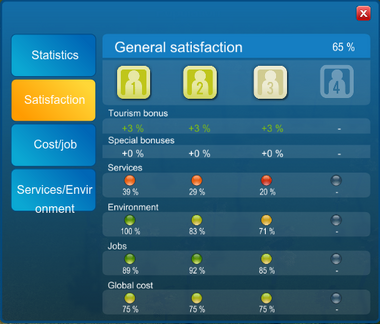
More information on Citizen satisfaction is available in the following places:
- Informational buttons in the Top Menu
There are series of buttons in the upper-right part of the screen that also show citizen satisfaction (one button per each wealth level). Clicking on them will give you immediate feedback for the citizen class in question, and also inform you of problems. Colour-code is: bright green - everything is topsy-turvy; dull green - some problems, nothing serious; yellow - problems requiring attention; red - you get the idea.
- Individual houses Informational panels
You can also click on individual homes to check their satisfaction. This will bring up the following information panel:
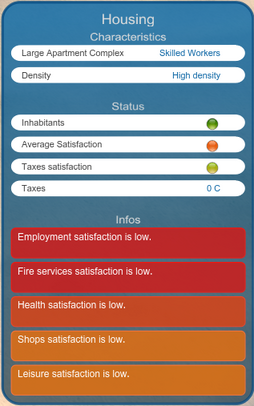
- Inhabitants shows the level of occupation of the house
- Average satisfaction gives you a general idea of the satisfaction level of the house (if it's red there's nobody living there currently).
- Taxes satisfaction reflects how well the residents of the house are doing financially (this satisfaction group includes all living costs).
- Taxes shows the amount paid by the house monthly to the city.
Underneath you'll find more specific info about what you need to improve. The more red the colour of the info, the more you need to improve it.
And here are the various satisfaction factors, in order of importance:
1. Jobs[]
An unemployed man is an unhappy man. Good thing that your city has so many ways to employ people! When you create a residential zone, always think if you'll have jobs for the relative type of citizens. If you won't, it's advisable to create some. Once you have a business somewhere in town to employ your new citizens, they'll find it automatically. Be careful to create the right business, though - look in the popup info panels of the businesses' tumbnails in the Construction menu to find what types of workers, and how many approximately they need, then select the appropriate business (according to your city strategy, of course).
If you click on a home, you'll see a colour line coming out of it and connecting it to a business somewhere in the city - this shows where the guys from that building work and is also handy to trace their way to work (which is important when solving traffic problems). If there's no line, then people in that building are unemployed - there's also gonna be a red warning text to that end.
Different jobs have different degrees of attractivity - working in a dirty factory is much less desirable than working in an office. Although, of course, every class will work something according to its qualification - an Unskilled worker in a factory will stay down with the dirty machines, while an Executive will be snugled up in the control rooms, supervising stuff. In a hotel, an Unskilled worker will be sweeping floors and cleaning rooms, while a Skilled one will be at the reception, etc.
Workers are constantly trying to find better jobs, and since industrial jobs are the worst, you'll see the most movement there - people will be constantly coming and going. That's why it is very important to keep transport to and from industrial districts well organized - if not, some factories might stay without workers long enough to go bankrupt!
On the other hand, once the citizen has a job, he will be satisfied (although looking for a better one), as Job satisfaction goes. The time it takes a citizen to reach his job, however, is a factor that also counts for job satisfaction and depends much more on your mayoral capabilities. The distance a worker travels, the means of transport he uses, the number of switches, the traffic he encounters all count towards his Travel Satisfaction (you could track this in the Layers>Transportation>Travel satisfaction). If a citizen becomes unsatisfied with travel time, he'll look to switch jobs into another, better served district, and he'll also become insatisfied with his current job.
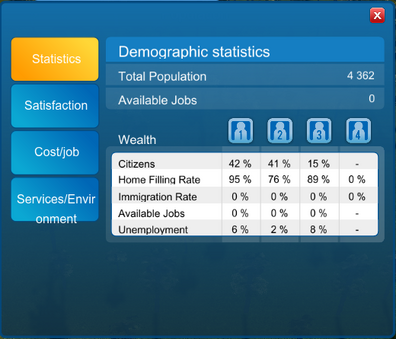
You can find general info on jobs and employment in the Population panel in the upper center part of the screen (between the resource and money tabs). Here, in the Statistics part you'll find your overall population, available jobs, the relative percentage of the different types of citizens, and the unemployment rate.
I like to keep a 1 - 2% unemployment rate for each citizen class - this guarantees that some new buildings that I erect will have workers right away, wihthout me having to worry about them. Creating large residential zones, especially in the early stages of a city, will create large unemployment rates, although you could create jobs just as fast. Don't get scared when you see 50% unemployment! With 5000 population you can turn that around with a single industrial zone.
In later stages of the game you can create citizen tokens by attracting more citizens than your city really needs. The excess will convert into citizen tokes, which you can use to trade, or in Megastructure projects. But be careful - lots of unemployed citizens that have nothing to do create problems!
- NOTE: houses containing unemployed citizens DON'T pay taxes! So, if you see a message 'Employment satisfaction is low', expect to see a reduction in the taxes the house pays, relative to the number of unemployed citizens there.
2. Services[]
Those include retail, education, health, police (security) and fire protection. Of those only retail will generate income for the city, the rest are expenses!
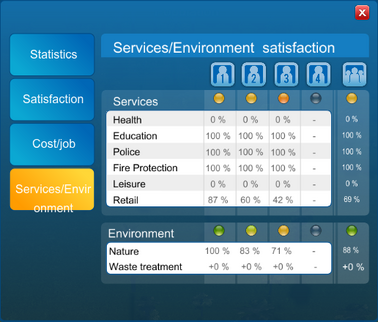
General Service satisfaction levels are shown in the Population>Services/Environment panel.
All services have limited range, even those that state that the range is 'city' (i.e. the entire city). However, the range isn't a fixed circle as in SC4; instead, it travels through the road network, and is thus subject to traffic. In short, if the streets around the service-providing building are congested, it's effective range diminishes. The tool allowing you to monitor service coverage is the 'Services' layout on the right side of the page. Here you'll find all types of services, and clicking on a particular service will light up the buildings that provide it, and the road network delivering access to it. Generally speaking, the greener the network - the more service coverage in that area. Bright yellow means middle coverage, faint yellow - low coverage.
Also, when your city grows, your citizens require more and more quality services, that is - bigger service buildings. You'll be forced to use more advanced buildings where before the basic ones did the job.
The different types of services are:
- Health
- Multipurpose stations. These babies provide all 4 services at the same time, but for an insane price. The Multipurpose Station has small coverage and costs 50000/mo (that's right, fifty grand), and the Multipurpose Center - 100000/mo, with bigger coverage. I guess you could use those if you're bathing in money and don't want to be bothered with creating 4 different coverage networks. Otherwise, it's pure waste.
3. Leisure[]
The next requirement of your citizens is someplace to have fun. Providing the necessary coverage is some work, since you have many types of leisure buildings with all sorts of effects and coverage areas. Again, as with Education, bigger is not always better here; you'll need to combine several kinds of leisure activities to satisfy your citizens. And of course, Eliter will require much more variety than Unqualified workers. And again, Leisure is city-funded, so you'll be spending a lot of money here.
We have two general types of leisure, found under the Commerce/Leisure tabs.
- Sports
- Cultural
Providing good leisure satisfaction will require a lot of play with combinations. Keep in mind that even the largest establishments (the tennis courts and the restaurant) don't have city-wide coverage; so be mindfull where you place everything. Use the Satisfaction/Leisure overlay to gauge effectiveness.
4. Environment[]
This includes the quality of air, how pleasant the neighborhood is, is there noise, etc. It is also known as 'Quality of life' and, overally, is the most difficult satisfaction category to provide, especially if your city is not a clean holliday-oriented paradise. You can check the status of the environment drom the 'Environment' layout . The following things influence environmental satisfaction:
- Air pollution - the ugly brown cloud over your industries will ruin not only this area, but also the quality of air in the entire city. There are 2 types of air pollution: direct (the said brown cloud), and indirect, which is a thin smog spreading over your entire map. The smog gets worse the more polluting agents you have, and bad news is that currently there's no way of cleaning it. you can only try to counter it.
- Noise pollution - not so dangerous, but still harmful to the Quality of life. Traffic produces noise pollution - you can see through the 'Environment/environment' layout that the areas around busy roads have lower quality of life satisfaction. All-too-realistic, also.
- Parks and plazas. Here I mean the 'Big parks ' (City services>Environment), the park- and plaza areas don't seem to help a lot (although they DO have an effect since a recent patch). The Big parks cost your city 3000/month, but they work relatively well to increase environmental satisfaction.
- Landmarks. Those special buildings also increase quality-of-life satisfaction. They have a circular area-of-effect (as well as the Avatar parks), so place them carefully in order to maximise their positive effect. Executives and Elites neighborhoods come to mind.
Cultural leisure buildings also provide lesser landmark effect .
- Waste treatment. Critical lack of Waste disposal services in the city (the resource is in the orange or red) will impact negatively Environmental satisfaction. After all, all these piles of garbage can't smell very nice, can they?
How to deal with environment? Well, the easiest thing to do is EVADE pollution. Don't build heavy and manufacturing industry. no power plants either. Your city will then have little problems with environment, and your parks and landmarks will provide the necessary boost to maximise this satisfaction type.
If you DO have industry, however, all you could do is to plan carefully your residential neighborhoods. Build them away from busy roads, build lots of parks and landmarks. It's interesting also that placing residences right next to farms works very well with this kind of satisfaction ('Ohhh, the pastoral view of cattle chewing grass on the other side of the fence ). Amd, we could hope FH will provide us with more tools to counter it in the future.
5. Tourism[]
This is represented in the game by the Holiday resource. As your city and population grows, you'll find that your citizens need holidays. Think of it as 'a nice place to spend the vacation'. If your city has holiday capabilities, you only need to construct holiday hotels to satisfy this need. Otherwise, you'll need to import holiday tokens. Lacking those will result in a negative bonus to all your citizen's satisfaction, a bonus that you can't counter. Currently, the negative bonus is -3 (if you keep the holliday deficit orange), or -6 (if it becomes red). Positive tourism bonus is also possible, but to achieve it you need to have overproduction to at least orange level.
6. Resources[]
Your population consumesresources directly as well as indirectly. This includes the 4 types of Utilities (energy, water, waste and fuel ), and also Food, Manufacturing andHigh tech industry . So, you'll need some amounts of those even if nothing else in the city consumes them. Of course, the level of consumption is nothing near what industries and other things will consume. Just don't be surprised when you see your food resource indicator going negative even though you haven't build more retail (the only other thing that consumes food).
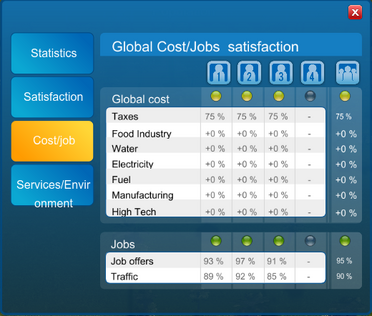
A good way to keep an eye on your citizen's resource needs is the Population - Cost/Job panel. Here you can see if some of the resources needed is so needed in the city that generates dissatisfaction. If everything's OK, you shouldn't see any negative numbers here. Again, if you're overproducing enough, you could receive positive bonuses.
7. Bonuses and Penalties (from excess supply and insufficient supply of resources).[]
The resources your population consumes (directly or indirectly): This includes the 4 types of Utilities (energy, water, waste and fuel ), and also Food, Manufacturing and High tech industry all factor into general satisfaction (through changes to cost of living (also known as global cost) and/or environment). Producing excess of these resources results in a bonus toward either the cost of living (for all listed previously except waste) or environment (for waste), provided the surplus is sufficient so that the demand/offer bar moves toward the offer side sufficiently enough to change the color of the bar from green to orange (see pictures below).
 |
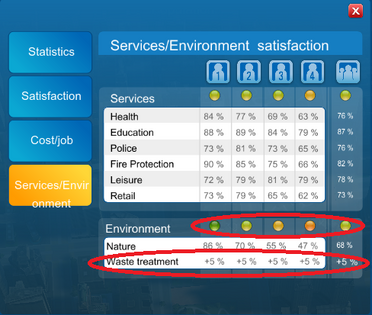 |
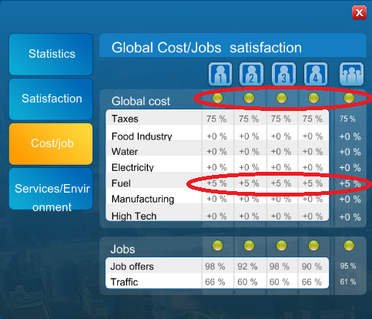 |
 |
Conversely, if there is such a lack of the resource as to move the demand/offer bar leftward toward the demand side and change the color from green to orange, a penalty will be applied to either the global cost or environment depending on the resource in question.
This bonus or penalty is 5% for orange and 10% for red.
8. Special bonuses[]
Those are provided by some special buildings, such as Landmarks and Megastructures . Look for the '+X satisfaction ' in their info tab. Once built, they'll add a permanent positive bonus to the relative wealth group's general satisfaction.
Closing comments[]
Note that the main Satisfaction for each class is comprised by a combination of four groups:
- Services - Education, Health, Fire protection, Police, Leisure and Retail all combine to provide this satisfaction
- Environment - the Quality of life + Waste treatment
- Job - availability of a job + travel satisfaction
- Global cost - a combination of the resources citizens need + tax levels
From the four components, Services weight twice as much as others, so if Total satisfaction = 1:
1=0.4(Services)+0.2(Environment)+0.2(Job)+0.2(Global cost)
We can easily see that the most efficient way of keeping your citizens happy is to provide lots of Services. Of course, this is related to great expenditures, since all Services but Retail are state-run.
On the other hand, the easiest way to satisfy them is to maintain clean Environment (no pollution) and keep your general economy running - so that citizens will have a job and all the goods they need at reasonable prices.
It depends largely on the type of city you're making what way you'll choose to satisfy your citizens:
- A Dirty city will have lots of pollution (mainly Air), so its Environmental satisfaction will be always low. This will also prevent development of several types of businesses that provide very good income (like Offices and High tech), so you'll need to concentrate heavily on Industry to provide enough jobs. This will lead to traffic issues (because of separating Industry from residential areas), which might also damage Job satisfaction. So, you'll need to maintain good Resource supply to keep Global costs good, and provide lots of Services.
- A Clean city will have good or very good Environment (it usually depends on the size of the city), Here the main problem will arise from concentrating activities in downtown areas (which creates traffic and Noise pollution), and the need to provide Landmark boosts to your Offices to maintain their profitability. Still, your Environmental satisfaction should be much better, so you could afford to spend less on Services while using all cash on Landmarks to maximise productivity from Offices and High Tech Industry, which will be your main trading means. You'll also need to import Utilities (you can't afford to mass-produce Electricity, Oil or Waste).
Of course, you could make a point of providing maximum satisfaction for your citizens - it's fun! A little difficult when you reach a million, though. Every huge city has its own problems and complications, which you'll need to find a way to overcome.
Monte Cristo's Orginal concept of Citizens[]
Because citizens are worth it
With City Life, we wanted to have a more realistic representation of human or societal interaction and to enrich the City simulation with a human factor. We came up with different population types with different needs, which we called Cultures. There were 6 of these groups - each had different levels of wealth and preferences for one type of civic service or another, e.g. a preference for education rather than police service.
City Life players, who have been a valuable source of feedback through the official forums and community websites, debated the culture concept a lot: Even if they generally liked the idea, we also heard that they weren’t all that fond of the buildings being heavily impacted graphically by the culture they belonged to, and that they didn't like the conflicts that appeared between the different culture groups.
We still believe that caring for the diverse needs of the inhabitants is an important part of city management – by inhabitants I also mean the companies within it - but especially the “human” residents. So we decided to review the concept of “cultures” from the ground up to in order to reach something more realistic.
The Citizen Profile
In real life, we can define for each citizen parameters that express things like their wealth, level of education, health, and the importance of security; stuff that is fairly common in most city builders. But what if we could have a deeper and more realistic set of needs and behaviors? To this end we created something that for the moment we are calling “citizen profiles”.
In CITIES XL, citizens will have a set of objective parameters that express who they are and what kinds of things are important for them. Here is a first and non-definitive look at the properties the Citizen profile may define:
Wealth
Citizens will have different salaries. In consequence, they will also spend their money in more varied ways. We define 4 levels of salaries that will correspond to 4 levels of wealth.
Education
Education allows the player to change the level of lifestyle of the city population. We defined 4 levels of education. The more efficient your education system is, the easier it is for them to develop and potentially rise to the next level of wealth…
Age
We defined 5 age groups for citizens:
- Child
- Young adult
- Parents
- Middle aged
- Retired
Each age range will have a direct influence on the citizens’ needs and behaviors. As your population ages slowly over time, the mayor will face new challenges: children will need an efficient education system while your retired citizens will need more leisure opportunities…
Sensitivities
Moreover, we want citizens to be sensitive to many different subjective parameters such as ecology, sports, originality, healthcare… The list is quite long and it will be part of the game to discover them all.
Citizen Care
You and I might live in a city for different reasons but we all share the same goal: being happy – or what we call “satisfaction”. If the city is not meeting your needs, you're dissatisfied with where you live, and the more vital or important the need is that is not being met, the faster the dissatisfaction grows. And if you are really not satisfied with where you live, you move out, and the city will stop receiving any taxes from you. Basically citizens in CITIES XL follow the same kind of behavior.
The satisfaction of your citizens depends on the characteristics of their profiles. For instance, if you have a high level of education, you would expect to find jobs with higher salaries than someone that has a low or nonexistent education. If there are no jobs available within commute distance, or at least no jobs at more than your minimal acceptable salary, you’ll probably move to another city. Or if you are very sensitive to ecology and your city decides to develop heavy industry near your place, you won’t stay for long…
But there's more...
Citizen profiles will impact different aspects of the overall game simulation, for instance the transport systems we know you love ;). Citizen sensitivities will be used by the simulation to determine which means of transport a citizen will use. A sports-oriented person in good health will be willing to travel longer distances using a bicycle than a rich old man who will be more likely to use his car. Or a citizen with a high sensitivity to ecology will be more likely to use public transport rather than a car…
Finally, your city population is in fact a diverse set of customers... What if we were to use their different parameters, their sensitivities and so on to determine how they consume not only the civic services your city provides, but also consumer goods and services in a realistic and logical manner...? We’ll introduce you in a future blog entry to the resource mechanisms we plan to implement in the game to create a more realistic city builder simulation. |}